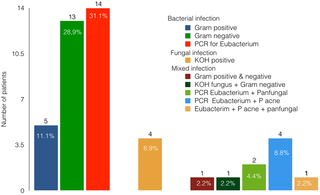PLOS ONE ( IF 2.9 ) Pub Date : 2018-01-16 , DOI: 10.1371/journal.pone.0191173 Muna Bhende , Rajiv Raman , Mukesh Jain , Pratik K. Shah , Tarun Sharma , Lingam Gopal , Pramod S. Bhende , Sangeetha Srinivasan , Malathi Jambulingam ,

|
Purpose
To describe the incidence, risk factors, clinical presentation, causative organisms, and outcomes in patients with endophthalmitis following pars plana vitrectomy (20G and minimally invasive vitrectomy surgery (MIVS).
Methods
Of 111,876 vitrectomies (70,585 20-G 41,291 MIVS) performed, 45 cases developed acute-onset, postoperative endophthalmitis.
Results
The rate of culture positive and culture negative endophthalmitis was 0.021% (2.1/10,000 surgeries) and 0.019% (1.9/10,000 surgeries) overall, 0.031% (3.1/10,000 surgeries) and 0.025% (2.5/10,000 surgeries) in 20G, and 0.005% (0.5/10,000 surgeries) and 0.007% (0.7/10,000 surgeries) in the MIVS group respectively. Potential predisposing factors were as follows: diabetes, 46.7%; vitrectomy for vascular retinopathies, 44.4%; and vitrectomy combined with anterior segment surgeries, 35.5%. The culture proven rates were 53.3% overall, 55.0% for 20G and 40.0% for MIVS. The most common organism was Pseudomonas aeruginosa for 20G. Klebsiella and Staphylococcus aureus were isolated in the two culture positive cases in MIVS group. The follow-up period for the patients with endophthalmitis was 586.14 ± 825.15 days. Seven were lost to follow up beyond one week. Of the remaining 38, 13 (34.2%) cases had a favorable visual outcome (i.e., best-corrected visual acuity [BCVA] > 5/200) and 24 (63.2%) had unfavorable visual outcome (BCVA < 5/200). Group with culture test results negative had significantly better outcomes (P < 0.05) as compared to those with positive.
Conclusions
MIVS does not increase the risk of endophthalmitis. Outcomes are poor despite appropriate treatment, particularly in cases with culture results positive.
中文翻译:

一家三级眼保健医院在111,876平面玻璃体切除术后发生眼内炎的发生率,微生物学和结局
目的
描述发生平面内玻璃体切除术(20G和微创玻璃体切除术(MIVS))后眼内炎患者的发生率,危险因素,临床表现,病原体和结局。
方法
在进行的111,876例玻璃体切除术(70,585 20-G 41,291 MIVS)中,有45例发展为急性发作的术后眼内炎。
结果
培养阳性和培养阴性眼内炎的发生率分别为2021G(0.021%(2.1 / 10,000外科手术)和0.019%(1.9 / 10,000外科手术),0.031%(3.1 / 10,000外科手术)和0.025%(2.5 / 10,000外科手术),以及MIVS组分别为0.005%(0.5 / 10,000手术)和0.007%(0.7 / 10,000手术)。潜在的诱因如下:糖尿病46.7%;玻璃体切除术治疗血管性视网膜病变,占44.4%;玻璃体切割联合前路手术的比例为35.5%。经培养证明的总体比例为53.3%,20G比例为55.0%,MIVS比例为40.0%。最常见的生物是铜绿假单胞菌(Pseudomonas aeruginosa),20G。克雷伯菌和金黄色葡萄球菌在MIVS组的两个文化阳性病例中分离出了这些细菌。眼内炎患者的随访时间为586.14±825.15天。七个星期后失去了跟进者。在其余38例中,有13例(34.2%)的视觉结果良好(即,最佳矫正视力[BCVA]> 5/200),而24例(63.2%)的视觉结果不利(BCVA <5/200)。文化测试结果为阴性的组与阳性结果相比,有显着更好的结果(P <0.05)。
结论
MIVS不会增加眼内炎的风险。尽管进行了适当的治疗,结果仍然很差,尤其是在培养结果为阳性的情况下。











































 京公网安备 11010802027423号
京公网安备 11010802027423号